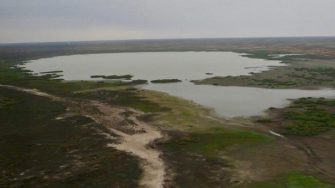
Date: Wednesday, October 11, 2017
Project: Eastern Australian Waterbird Survey
Cool weather is a delight when aerial surveying. It also generally means more stable conditions and thus more comfort for the three of us in the single engine plane.
When we set out from St George at 6.30am we knew we would encounter rain later in the day. This proved to be the case when light rain began to splatter the windscreen just after we counted numerous waterbirds on the two remaining Bulloo Lakes which held water from last year’s flood. The light rain continued until we landed at White Cliffs about 3pm.
Vast irrigation developments exist in the St George/Dirranbandi area and they appear to be expanding since I last visited on the survey in 2015. Cubbie Station has large off-river storages just outside Band 6.
Photo: Terry Korn
Between St George and Cunnamulla many bore drains still flow so some stations in this area have yet to log onto the Cap and Pipe the Bores program. These shallow drains snake their way across the landscape.
South of Tibooburra in the western part of Band 5 all wetlands were dry because of the drought. The light rain caused ponding on the clay pans which in turn attracted kangaroos and emus to drink and bath. Almost every clay pan had kangaroos sipping the shallow water in the 20 degree temperature.
The eastern Bulloo Lake still holds good water. Photo: Terry Korn
Only two areas today had any numbers of waterbirds:
The Bulloo Lakes, a terminal system at the end of the Bulloo River just north of the NSW border east of Tibooburra; and the Mullawoolka Basin in the Lower Paroo complex east of White Cliffs. The latter is very shallow but it was buzzing with Pink-eared ducks, Grey teal and Avocets. All other lakes in the Paroo complex are dry.
The Mullawoolka Basin Lake on the Paroo River. Photo: Terry Korn
